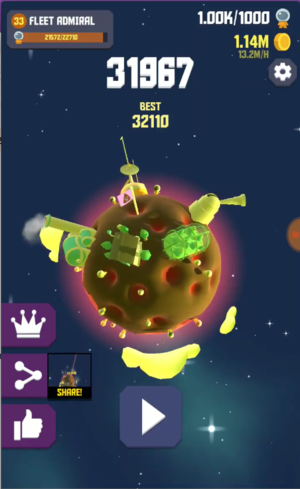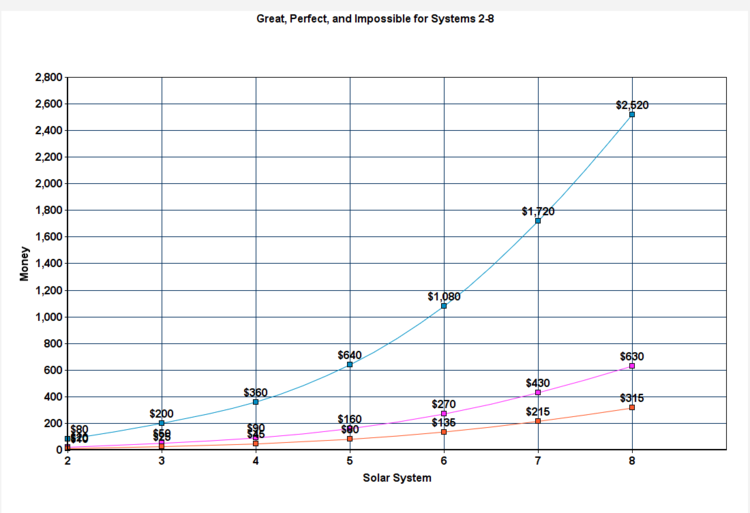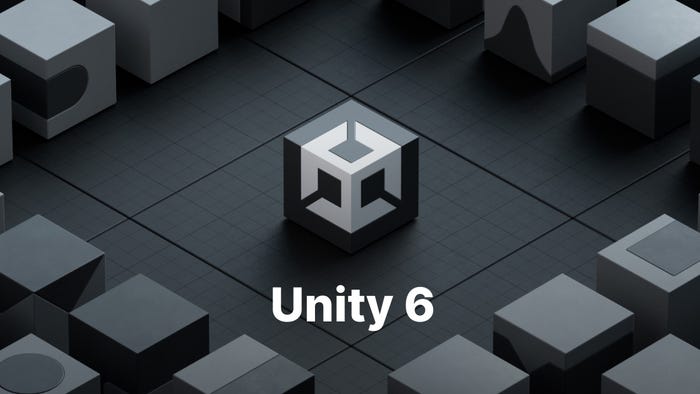
Featured Blog | This community-written post highlights the best of what the game industry has to offer. Read more like it on the Game Developer Blogs.
Space Frontier 2: Game Design in Depth
A detailed look at the game mechanics underlying Space Frontier 2

Basics
Space Frontier 2 is a space exploration game published by Ketchapp and developed by Part Time Monkey with Design by LynxSwamp. It is free on iOS and Android.
The game tasks the player with exploring the galaxy one solar system at a time.
The player launches a multistage rocket into space and then taps the screen in order to detach each stage of the rocket. Detaching a stage reveals another rocket booster which propels the rocket further into space.
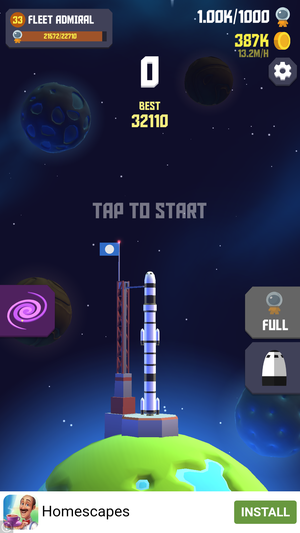
Each planet reached is colonized by the astronauts on board the rocket. These astronauts passively generate money that can be spent on rocket upgrades, more astronauts, and further exploration into the galaxy.
Core Loop and Metagame
The core gameplay for Space Frontier 2 is launching the multistage rocket into space to land on planets. The player repeats this process to generate money.
The metagame is exploring the galaxy and reaching new solar systems. Each new system contains the same core gameplay as the first. The difference being that the rewards for rocket launches and cost of upgrades are all higher.
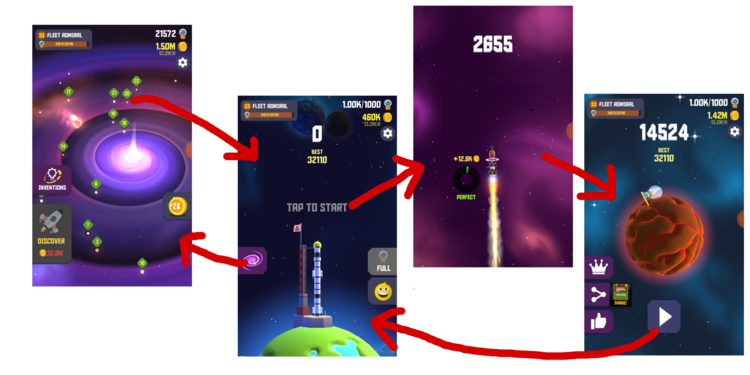
Launch and Landing
The launch begins by tapping the rocket. Each additional tap will detach a stage of the rocket. The later the tap, the more money that is rewarded, and the further the rocket will go. However, tap too late and the rocket will explode.
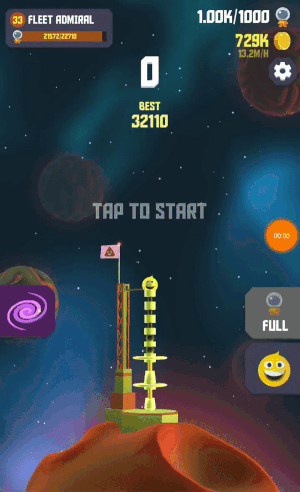
The tap timing mechanic is represented by a circular dial that depletes in a counter clockwise direction.
There are 5 different ratings for rocket detachment: Ok, Good, Great, Perfect, and Impossible. The latter 3 will reward the player with money. In the first solar system, Great pays $10, Perfect pays $20, and Impossible pays $80.
These rewards increase in successive solar systems. The first 8 are shown in the table below:
System | Great | Perfect | Impossible |
|---|---|---|---|
1 | $10 | $20 | $80 |
2 | $10 | $20 | $80 |
3 | $25 | $50 | $200 |
4 | $45 | $90 | $360 |
5 | $80 | $160 | $640 |
6 | $135 | $270 | $1,080 |
7 | $215 | $430 | $1,720 |
8 | $315 | $630 | $2,520 |
The base Great payout determines the other two. Perfect is always twice as much as Great and Impossible is always eight times as much as Great.
Disregarding the first two planets, the payouts increase exponentially. This graph illustrates that point. You can see how much separation the Impossible eight times value makes the further into the galaxy the player explores.
Landing on planets also rewards money. The further the planet in the solar system, the more money that is rewarded. Just like the stage detaching payouts, these also increase exponentially between solar systems.
System | Planet 1 | Planet 2 | Planet 3 |
|---|---|---|---|
1 | $45 | $90 | $135 |
2 | $45 | $90 | $135 |
3 | $75 | $150 | $225 |
4 | $120 | $240 | $360 |
5 | $195 | $390 | $585 |
6 | $300 | $600 | $900 |
7 | $450 | $900 | $1,350 |
8 | $645 | $1,290 | $1,940 |
There are about a dozen planets in each system, however we only need 3 to notice the payout pattern. In each of the solar systems, Planet 2 is twice the value of Planet 1 and Planet 3 is three times the value of Planet 1. Therefore we can just use this equation to solve for the cost of each planet:
Planet X Reward = Planet 1 Reward * X
This is simply a linear equation. However, the payouts between Solar Systems (disregarding the first 2) is exponential.
An interesting fact about landing on planets. As long as the rocket doesn't blow up, it will almost always land on a planet. There is a brief period before reaching the first planet where the rocket will just float in space endlessly. However, once the rocket passes the first planet, it will always land on one.
I think this attributes to the casual nature of the game. It's really hard to reach a losing state. The game keeps pushing the player forward, skill will just help progress faster.
Rocket Upgrades
Rocket upgrades will add an additional stage for more boosting power. This enables the rocket to go further and land on more valuable planets.
In the first system, the cost for the first upgrade is $60 and then every future upgrade is $60 more. So the 5th upgrade would be $300. Again, this is a linear increase. However, between solar systems is again an exponential increase.
System | Cost per Rocket Stage |
|---|---|
1 | $60 |
2 | $260 |
3 | $890 |
4 | $2,210 |
5 | $4,530 |
6 | $8,170 |
7 | $13,500 |
8 | $20,800 |
When I say exponential I mean that we can match a polynomial equation to these data points.
Using a site like http://www.xuru.org/rt/PR.asp I plot the data points and can get an approximation of a polynomial equation up to a selected polynomial degree. If the degree is 2, then the equation would look something like:
y = a + bx + cx^2
A degree of 3 would add dx^3 onto the end of that equation. The higher the polynomial degree, the more accurate the equation. While I could just select a degree of 10, it's best to simplify the equation as much as possible while still staying accurate.
With the above data set (and some rounding) we get an equation of:
y = 53 x3 - 129 x2 + 245 x - 118
We can then use this equation to make a prediction about future solar systems. If we plug in 9 for x then we get $30,400, which turns out to be the correct cost for the first rocket upgrade in the 9th solar system.
I think these kinds of equations are interesting to figure out because we can start to dissect the math in the design of the game. This is especially true for a game with idle mechanics like this one where how much money the player has is directly proportional to their progress within the game.
Astronauts
We've covered the basic way of making money within the core gameplay loop. However, the biggest money making venture comes from colonizing the planets with astronauts. This is done by simply landing on a planet while the rocket contains the little explorers.
Each ship starts with 1 astronaut on board. The player must pay for each additional astronaut. In the first system, the first astronaut to board the rocket costs $1, the second is $2, then $3. A linear progression just like the rocket upgrades.
If the rocket successfully lands on a planet, each astronaut will generate money over time. In the first system, each astronaut generates $11 per hour. This is the idle mechanic in the game and is where the real money comes in.
It's worth noting that it does not matter which planet the astronauts land on, they all generate the same amount of money.
It should be expected at this point that I'm going to look at the costs and idle generation of these little space cowboys between different solar systems. Let's look at a graph comparing the cost to the per hour rate.
System | Cost per Astronaut | $/hour for each Astronaut |
|---|---|---|
1 | $1 | $11 |
2 | $4 | $22 |
3 | $8 | $33 |
4 | $13 | $44 |
5 | $21 | $55 |
6 | $29 | $65 |
7 | $40 | $76 |
8 | $52 | $87 |
9 | $65 | $98 |
10 | $81 | $109 |
11 | $97 | $119 |
12 | $116 | $130 |
13 | $136 | $141 |
14 | $157 | $152 |
The hourly generation of each astronaut increases linearly while the cost increases exponentially. This means that over time it will take longer for the astronaut to make up for it's initial cost. Meaning that the further the player gets into the game, the longer it will take to get enough money to explore more solar systems.
In the first solar system, the first astronaut costs $1 and generates $11 per hour. So that astronaut is net positive after 1/11 of an hour or 5.5 minutes. Each additional astronaut will be an additional 5.5 minutes of time to become net positive due to the linear nature of the cost.
For the 14th solar system, the first astronaut generates $152 per hour while costing $157. That astronaut will be net positive after about 1 hour of real life time. Each additional astronaut is another hour on top of that. If the player loads up a rocket with 72 astronauts, that last astronaut isn't profitable until 3 days later.
This is one way the game is extended the deeper the player is in the game. If the player is already hooked on the game, the developers don't need to reward them with a new solar system nearly as often as early players.
Monetization
Other than the standard banner and interstitial ads, Space Frontier 2 has a wide variety of rewarded ads. This is where developers get creative in their monetization efforts.
How can the developers reward the player for watching an ad while also not making them feel like it is required to progress in the game? Good rewarded ads strike this balance well.
Rewarded video to unlock new rocket skin
When the player lands on a planet, sometimes there will be a piece of cargo floating in it's orbit. These contain new rocket skins. To unlock it, the player MUST watch a video ad.
While I'm not sure I 100% agree with locking skins behind a 30 second ad, I do like that this rewarded ad has no affect on gameplay. A lot of the time, I did find myself watching the ad because I wanted some variety in my rocket.
An interesting bit about this is that the player finds the piece of cargo and will actually lose the cargo if they continue on without watching the ad.
This is a psychological tactic known as loss aversion. The game threatens to take away something that the player acquired through playing the game. We, as humans, don't like this. It is much more likely that we will watch the ad to avoid LOSING the cargo than if the situation was reversed. For example, if they said we could watch an ad in order to GAIN a new skin. The former is also much more immersive within the game universe.
This is a recent trend I have seen in a couple other games. Most notably Hooked inc by Lion Studios. Where the player fishes out a treasure chest full of the premium gem currency. The catch is that they can only get the gems inside if they watch an ad.
2. Rewarded video to add 30 astronauts to the rocket
This is useful if the player is very impatient with the current pace of the game. Even if the player doesn't have enough money to add astronauts to the rocket, they can still keep doing that by watching an ad.
It's worth noting that the best strategy is to buy astronauts first and THEN use this rewarded ad because those later astronauts cost more money.
3. Rewarded video to increase idle profits
This will increase the colonizer idle profits by 2x or 5x for a certain amount of time. The 2x boost can be done anytime in the galaxy view. The 5x boost is acquired similar to the cargo and is represented as a satellite orbiting a planet.
This is a pretty standard rewarded ad and will just speed up the gameplay a bit.
4. Rewarded video to save the astronauts if the rocket explodes
This is by far my favorite. I use it almost every time because it really plays on loss aversion. Not only did the rocket explode but all the astronauts shoot out in a glorious animation. The player loses the astronauts, the money spent on them, and the time for that launch. Watching the ad reduces that loss.
Honestly, I think this is a brilliant rewarded ad mechanic. The player is not getting towards the goal faster, they are just not losing as much as they could.
There is also a paid subscription service. It's something like $7 per week and gives some bonuses. This is really just going after the whales and impatient players as it's really not required to progress in the game. Most of the benefit is just progressing through the game faster.
Comparison to Space Frontier 1
This game made multiple changes from the first game.
Bigger and better metagame
The first game was limited to just 3 planets. However, it takes more time to get to those planets than a planet in Space Frontier 2. It's about as equal to discovering a new solar system.
Where Space Frontier had 3 of these planet/solar system starting points, Space Frontier 2 has somewhere in the ballpark of 100.
There is also no metagame screen in the original. The galaxy view really encourages exploring new planets and gives the player a good sense of progress. I actually had to look up online if there were additional planets in the original because the game doesn't spell out a definitive end.
2. Different rocket detachment mechanic
The first game had an integrated rocket detachment mechanic. Each rocket stage shrunk up into the rest of the rocket and the player had to tap when it was almost to the next stage. This is in contrast to the simple circular dial in the sequel.
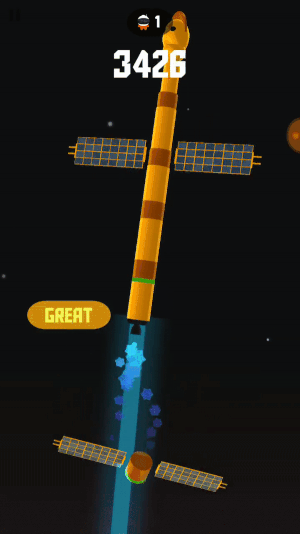
I would argue that there are positives and negatives to both. Most people I've talked to believe that the original mechanic was better because it was more immersive. And I agree, it was much more immersive. However, it was also hard to know when to tap. The rocket literally goes up into itself, which means the player can't clearly see when to tap for a perfect rating.
I think some kind of middle ground could have been achieved where the player has a better visual indicator of when to tap combined with a more immersive mechanic.
Game Juice
Game Juice - additions to the game that increase responsiveness to player interaction and a sense of good "feeling". Most of these don't affect gameplay and are visual or audio in nature.
Rocket Lerp
First, lerp is short hand for linear interpolation. This is a method of fitting a curve to construct new data points within a range of known points.
One of the coolest things the developers use this for is when landing on a planet and discovering a new solar system.
There are 2 known points, the starting rocket point and the landing point. Instead of just using a straight line, the rocket goes in a non-linear path.
In the instance of landing on a planet, this looks like the ship gets stuck in the planets gravitational pull as the rocket flies past the planet. It slows down until reversing course to land on the planet.
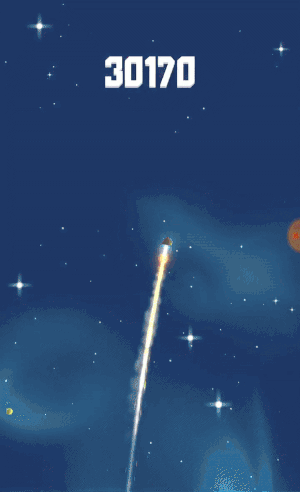
The lerping for discovering a new solar system is less representative of real life physics and more just for fun. The rocket will do a large loop before arriving at it's destination.
2. Adding astronauts to the ship
Every time the player taps to purchase an astronaut, a tiny suited up human will appear on the launch pad and board your ship. Doing this a bunch of times in a row is very entertaining as loads of space explorers board the ship all in a line.
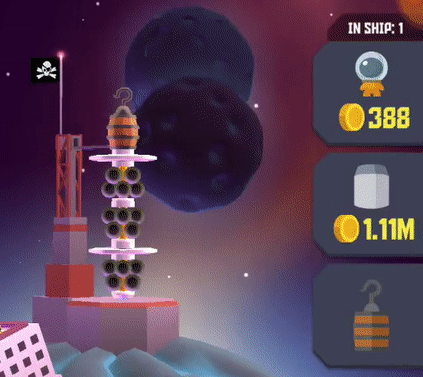
3. Rocket detachment
This whole process is just really juicy. The circular dial has sparks coming off it, tapping turns the whole dial a color related to how well you did. At the same time the rocket stage detaches and flies off into space as the rest of the rocket keeps thrusting upwards.
Final Thoughts
I think this game excels at different aspects of what makes for a good casual game:
It has a simple core loop that is very juicy.
The metagame is well incorporated into the theme of the game and keeps the player moving forward with a good sense of progression.
There is a variety of rewarded ads that feel fair to use but not necessary to progress through the game.
The graphics and sound effects are high quality and cohesive.
Of course there are always improvements that can be made.
Tap Mechanic
The tapping mechanic could be more immersive. They took a step backwards from the first game in that respect.
Metagame Gets Old
The metagame got pretty old after a while. I think this is hard to avoid with casual games. Everyone will get bored of the core gameplay at some point and for me it was after 25 solar systems.
More specifically, I reached a point in the game where I almost stopped worrying about money. At about solar system 15, I discovered that I was making so much money from that system, that I could go back to system 1 and very quickly max it out to 1000 astronauts. At the current moment, I am at system 25 with all previous 24 systems maxed out. Every day I generate enough money to explore a new system with enough left over to max out the previous system.
With this strategy, I can check into the game once per day and explore one more solar system. It was at this point that I got pretty bored with the game. The sense of exploration had come to an end and there were no new mechanics to discover.
I have also been able to figure out how long it will take me to explore the next galaxy. By comparing my hourly income to the cost of the next solar system. I found that the time to do so increases steadily.
In the table below, for each current system I have 100 astronauts and a max of 1,000 astronauts in all previous systems.
Current System | Next System Cost | Hourly Income | Time to Next System |
|---|---|---|---|
20 | $19.3mil | $2.08mil | 9.28 hours |
21 | $23.2mil | $2.29mil | 10.13 hours |
22 | $27.6mil | $2.52mil | 10.95 hours |
23 | $32.6mil | $2.76mil | 11.81 hours |
The time to next system is calculated by taking the next system cost and dividing it by the hourly income.
This means that the later solar systems will start to take multiple days to explore. Of course, there are the rewarded ads that will double your idle income so progress could be sped up.
One thing that each new solar system brings is a new rocket 'invention' that changes the appearance of the rocket. It is cool to see the rocket evolve but not enough to keep me going, especially if those 'inventions' don't change the mechanics of the game.
For more design analysis like this, visit the Lit A.F. Games website. I hope you enjoyed reading this design analysis of Space Frontier 2. Please comment here or wherever you found this article so we can continue the discussion!
Read more about:
Featured BlogsAbout the Author(s)
You May Also Like

